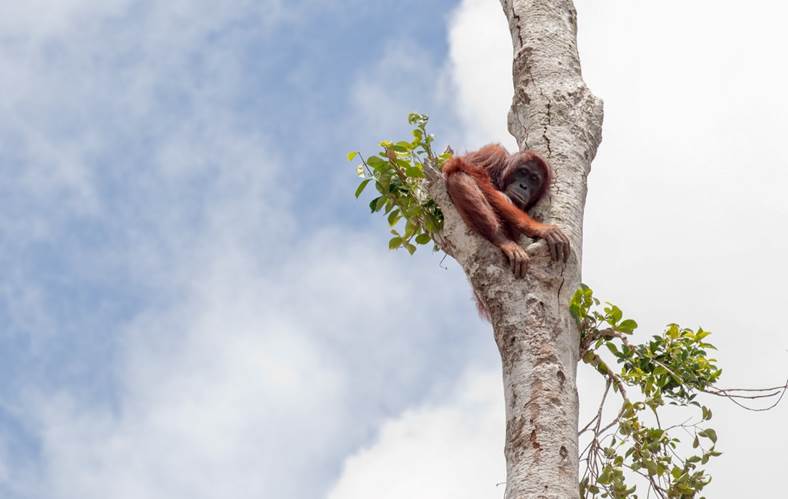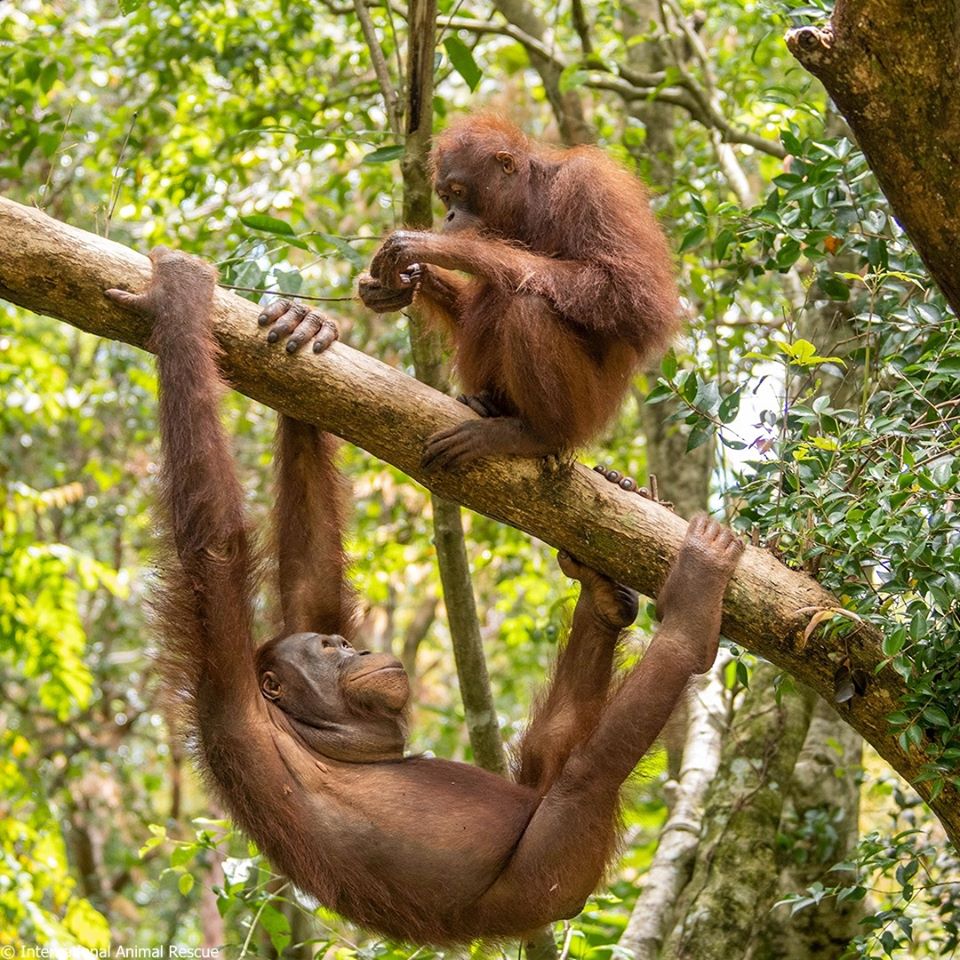Get ready for International Orangutan Day – August 19th!

Orangutans are beautiful, intelligent, and charismatic. Adult male orangutans look impressive and majestic when they grow cheekpads (flanges); female orangutans are outstanding mothers; and orangutan babies, with those pink faces and wild tufts of hair, are irresistibly cute. It’s no wonder the world celebrates International Orangutan Day every August 19th to bring attention to the precious red apes. We present you with 10 essentials to know about orangutans that you can share this Orangutan Day. Spread the word about these special souls!
Learn more about International Orangutan Day
1.The Earth is Blessed with 3 Species of Orangutan

There are three species of orangutans: Bornean (Pongo pygmaeus), Sumatran (Pongo abelii), and Tapanuli (Pongo tapanuliensis). All the orangutan species are gorgeous, but they do have unique physical characteristics. Bornean orangutans differ from the others with a larger stature; wide, round cheek pads; shorter and darker hair; and a shorter beard and pointed head. Sumatran orangutans are smaller in stature; have a longer, more narrow face, their hair is longer and lighter, and they present with a longer beard and flat head. The rare Tapanuli orangutan, although similar to Sumatrans, was described as a distinct species in 2017. They have flat cheeks; a frizzier hair texture; and big mustaches.
2.The Precious Red Apes are Critically Endangered

All three species of orangutans (Bornean, Sumatran, Tapanuli) are critically endangered. Species are categorized by the International Union for Conservation of Nature (IUCN) and a species is considered critically endangered if it has an extremely high risk of extinction in the wild. This is based on current numbers of individuals; how quickly the species can reproduce and repopulate; the number of individuals needed for a viable, stable population; and the threats the species face. It is difficult to get an accurate count of wild orangutans. Estimates indicate that there are less than 13,000 Sumatran orangutans left in the wild, and less than 70,000 Bornean orangutans. Only about 800 Tapanuli orangutans live in the wild, making them the most endangered of the orangutan species.
3. Only Two Islands for Orangutans

Wild orangutans are found in only two places on Earth – on the islands of Sumatra and Borneo in SE Asia. Orangutans are the only great apes that live in Asia (all the other great apes – gorillas, chimpanzees, and bonobos – live in Africa). The word “orangutan” translates to “man of the forest”, and the forest is where they live. The precious apes are not found across the entirety of the islands, but rather in pockets of forest due to rapid deforestation.
4. Two Countries for Orangutans

Sumatran and Tapanuli orangutans live only on the island of Sumatra which is a part of the country of Indonesia. Bornean orangutans live only on the island of Borneo, and that island is transnational. Part of the island belongs to the country of Malaysia and the larger part belongs to the country of Indonesia. (Therefore, Bornean orangutans may live in the country of Malaysia or the country of Indonesia.) This is significant as the governments of each country must do their part to enact and enforce laws to protect the orangutans.
5. Orangutans Lead Semi-Solitary Lives

Once they reach adulthood, orangutans spend most of their time alone, unless they are a mother with her offspring. The unique ecology of orangutans dictates their solitary lifestyle. However, orangutans can be quite social. Females may feed in the same trees, and youngsters will play together. Research has shown that during play orangutans tickle and punch each other playfully. It is important to remember that humans should never approach orangutans in the wild, even if the animals appear docile. Orangutans have gentle and timid personalities and they generally try to avoid humans in the forest. These apes are wild animals and need to be treated with care and respect, which includes keeping distance and not disturbing the orangutans.
6. The Orangutan Mother-Child Bond is Very Strong

Orangutan mothers give birth about once every eight years, and the babies stay dependent on their mother longer than is the case with any other animal. An infant will stay physically attached to their mother for the first year, and then slowly start to move about on their own. Youngsters nurse until about six years of age and after this time, the mother will be receptive to mating once again. Females may stay close to their mothers until they are in their teens, observing and learning from the older females’ parenting skills. A beautiful sighting is a mother and her infant, with her older offspring close by.
7. Orangutans Need the Forest

Orangutans are perfectly suited to live in the forest having long arms (the longest of the great apes) for reaching from tree to tree, with long fingers and short thumbs perfect for gripping and swinging on branches. With males weighing up to 200 pounds and females weighing near 130 pounds, orangutans are the largest and heaviest tree dwelling mammals. And high up in the trees is where they stay. Orangutans travel through the treetops, eat from the fruit trees, and build nests to sleep in that are up to 100 feet above the ground. Orangutans have large home ranges with females having a range of 3.5 square miles, and males having home ranges of up to 15 square miles which do not overlap with other males. Orangutans require a very large and undisturbed rainforest area in order to survive in the wild.
8. The Forest Needs Orangutans

Orangutans need the forest and it is equally true that the forest needs orangutans. In fact, these apes are vital to the health of forests. Orangutans are the gardeners of the forest, and they keep it thriving. Orangutans are important seed dispersers, assuring that the trees will continue to grow. In addition, the way in which orangutans bend down tree branches to make nests allows light to penetrate down into the forest, which keeps it flourishing. Forests play an important role in our planet’s carbon cycle. The forests are full of trees that produce oxygen, store carbon dioxide, and help control climate. The presence of orangutans leads to healthy forests, and healthy forests leads to a healthy planet.
9. Threats to Wild Orangutans

While Sumatran orangutans need to be aware of predators such as tigers, the biggest threat to all orangutans is the activity of humans. Orangutans are in danger from illegal poaching and capture of baby orangutans for sale on the black market. They are threatened by human-orangutan conflict as apes move closer to villages when their forest homes are destroyed. While there were once hundreds of thousands of orangutans living in the forests, now they are threatened by extinction in Sumatra and Borneo due to the destruction of the rainforest. Logging, road construction and clearing land for agriculture (I.e. industrial scale oil palm plantations) and mining (gold, coal, zinc, lithium) are among the reasons orangutan populations have been decimated in the wild.
10. Wild Orangutans Need Our Help

To help wild orangutans, you can support the rescue and rehabilitation centers caring for the displaced and orphaned orangutans. It is also important to support the organizations working to protect forests. Virtual adoptions and donations to Orangutan Outreach support incredible organizations across Indonesia.
Learn more about International Orangutan Day
